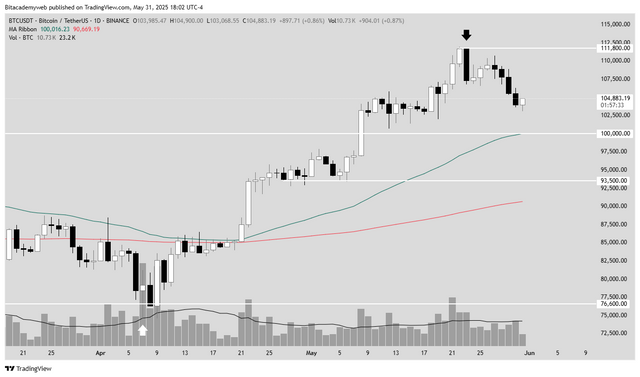The reigning cryptocurrency is navigating turbulent waters following mixed US inflation data, the specter of tariffs, and Japanese intervention, keeping traders on the edge of their seats.
The price of Bitcoin (BTC) is in a delicate balance, hovering around $104,000 at a crucial inflection point. The leading cryptocurrency is torn between a resistance zone at $111,800, where it previously suffered rejection, and firm support at $100,000, now solidly supported by the 50-period exponential moving average (EMA50). This limbo occurs in a complex macroeconomic context, marked by mixed US inflation data, a strong dollar driven by Japan's intervention in its bond market, the recent decline in US GDP, and the persistent threat of a tariff war following President Donald Trump's statements.

While the long-term uptrend appears intact, price exhaustion and proximity to the key support at $100,000 suggest that the next moves will be crucial in determining Bitcoin's short- and medium-term direction. / Tradingview
Inflation Data in Focus: A Contradictory Outlook
The Core PCE Price Index (PCE), a key indicator of underlying inflation, showed monthly stability at 0.1% MoM, in line with market expectations. Year-over-year, the rate moderated to 2.5% YoY, slightly lower than the previous 2.7%. This result confirms a gradual inflation slowdown, although the figure still remains above the 2% target set by the Federal Reserve (Fed).
On the other hand, the headline PCE (which includes volatile food and energy prices) also registered a monthly increase of 0.1% MoM, in line with forecasts. However, the year-over-year rate rebounded to 0.8% YoY, exceeding the previous 0.7% and consensus expectations of 0.3%. This increase is partly attributed to the inherent volatility of energy and food prices, although the underlying inflation trend appears to remain moderate.
The Impact on Bitcoin's Price: A Game of Contradictions
These contradictory inflation data generate several forces that could influence Bitcoin's price:
Favorable Macroeconomic Context: The moderation of underlying inflation, along with expectations of less pressure from the Fed's monetary policy, are generally considered positive factors for BTC. A reduced need for monetary tightening reduces the relative attractiveness of the US dollar and Treasury bonds, providing room for alternative assets like Bitcoin to thrive.
Potential Increased Demand as a "Hedging": If markets interpret that the Fed may be forced to consider interest rate cuts sooner than expected due to the economic slowdown (reflected in the recent GDP data), Bitcoin could experience increased demand as an asset uncorrelated with traditional monetary policies and as a potential hedge against economic uncertainty.
Short-term volatility risk: Despite the moderation in the Core PCE, the rebound in the year-over-year headline PCE could raise some concerns in the market. If investors interpret headline inflation as remaining more persistent than expected, it could trigger selling pressure on assets considered more speculative, such as Bitcoin, in the short term.
Waiting for a decisive breakout
The CMC Crypto Fear and Greed Index currently stands at 55, indicating a neutral zone in market sentiment, reflecting the uncertainty surrounding Bitcoin's price direction.
The MVRV-Topping Cloud indicator, which analyzes the relationship between Bitcoin's market value and realized value, registers an MVRV-Z of 0.45, also considered neutral, offering no clear signal of extreme overbought or oversold conditions.
From a technical perspective, while Bitcoin maintains an uptrend by trading clearly above the EMA50 and EMA200, both aligned upwards on the daily chart, the price is showing signs of exhaustion. This could be a pullback or technical retracement towards the $100,000 support zone before potentially resuming its uptrend. Importantly, the trading volume recorded during this correction was lower compared to previous days, suggesting that sellers do not have particularly strong conviction in this downward movement.
Navigating Uncertainty
The Bitcoin price is at a crossroads, influenced by a complex interplay of macroeconomic data, geopolitical events, and market sentiment. Mixed US inflation data, a strong dollar, and the persistent threat of tariffs keep uncertainty high. While the long-term uptrend appears intact, price exhaustion and proximity to the key support at $100,000 suggest that the next moves will be crucial in determining Bitcoin's direction in the short and medium term. Investors and traders should closely monitor the evolution of these factors to anticipate a potential breakout, either upward through resistance at $111,800 or downward through testing support at $100,000.
Disclaimer: This article is for informational purposes only and does not constitute financial advice. Investing in cryptocurrencies involves significant risks. Always conduct your own research and consult a qualified financial professional before making any investment decisions.
Upvoted! Thank you for supporting witness @jswit.
Downvoting a post can decrease pending rewards and make it less visible. Common reasons:
Submit